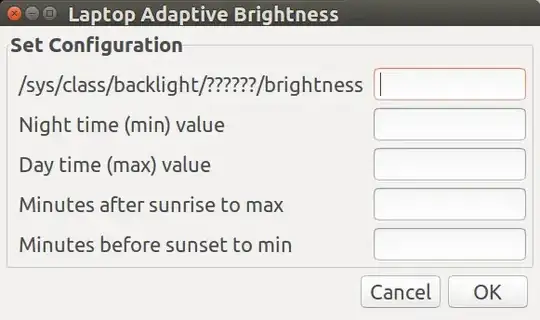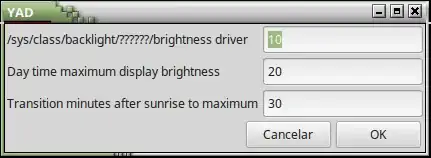Zenity can only display previous value when there is only one entry field. As such the code below puts the previous values into the label fields and instructs user to type new value into entry fields or leave it blank to keep existing value.
The Bash Code
#!/bin/bash
# Read configuration file with entries separated by " " into array
IFS=' ' read -ra CfgArr < ~/bin/adaptive-brightness-configuration-file
# Zenity form with current values in entry label
# because initializing multiple entry data fields not supported
output=$(zenity --forms --title="Laptop Adaptive Brightness Configuration" \
--text="Enter new settings or leave entries blank to keep (existing) settings" \
--add-entry="/sys/class/backlight/??????/brightness driver : (${CfgArr[0]})" \
--add-entry="Day time maximum display brightness : (${CfgArr[1]})" \
--add-entry="Transition minutes after sunrise to maximum : (${CfgArr[2]})" \
--add-entry="Night time minimum display brightness : (${CfgArr[3]})" \
--add-entry="Transition minutes before sunset to minimum : (${CfgArr[4]})")
IFS='|' read -a ZenArr <<<$output # Split zenity entries separated by "|" into array elements
# Update non-blank zenity array entries into configuration array
for i in ${!ZenArr[@]}; do
if [[ ${ZenArr[i]} != "" ]]; then CfgArr[i]=${ZenArr[i]} ; fi
done
# write configuration file using array (fields automatically separated by " ")
echo "${CfgArr[@]}" > ~/bin/adaptive-brightness-configuration-file
I was surprised after hours of googling, examples of this code couldn't be found. Hopefully others googling the same problem can find this code.
The Screen
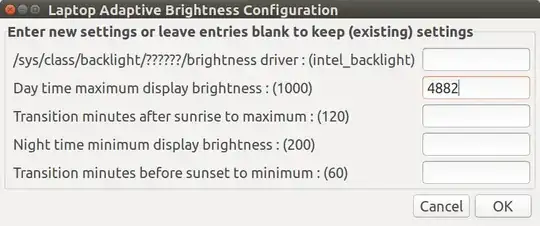
In this answer the zenity form has a different order and expanded labels for fields. Although 4882 is maximum for this intel_backlight driver it's like staring into the sun and 1000 is practical maximum indoors.
Many thanks to muru for guidance converting original code from old-style COBOL format using field names, to modern Bash format utilizing arrays.
Using yad instead of zenity
In 2018 I revamped the project and renamed it to Eyesome. Now it uses yad which is a super-charged forked version of zenity. yad uses the same coding style in bash and adds more functionality.
Notebook support for multiple tabs
Using yad you can display current field values plus create forms in tabbed notebook format:
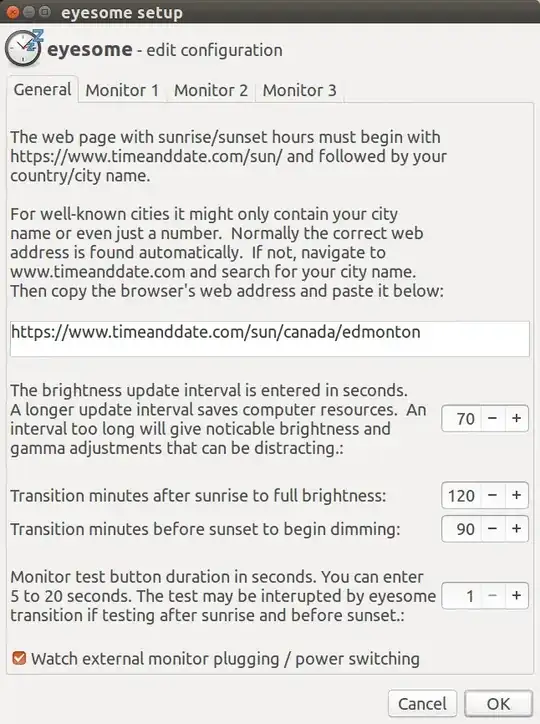
Whilst writing this answer I noticed the screen was out of date and says 5 to 20 seconds. I've changed it to say 1 to 20 seconds for the next publication.
Monitor 3 from the tab list
Here is what Monitor 3 looks like from the tab list:
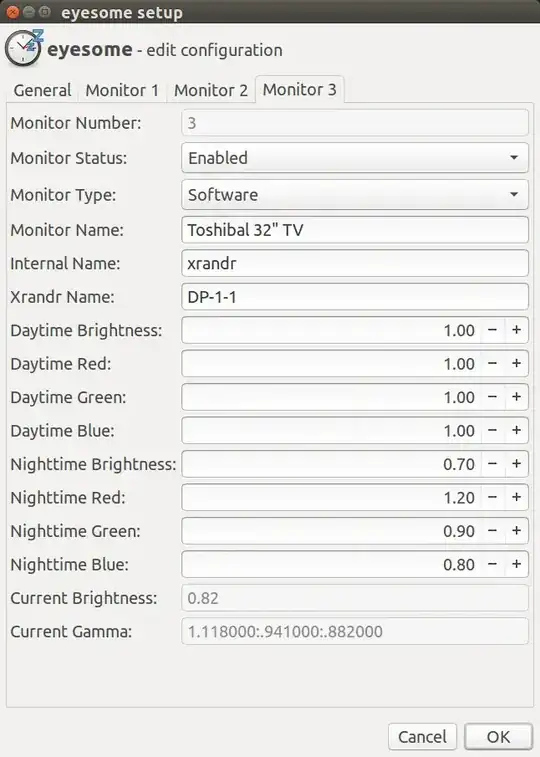
Sample code for generating this screen is listed in the next section.
Sample code
The three monitors share a common function to build the bulk of the code. For Monitor 3 we use:
# Monitor 3 notebook page
BuildMonitorPage "$CFG_MON3_NDX"
yad --plug=$KEY --tabnum=4 --form \
"${aMonPage[@]}" > "$res4" &
The BuildMonitorPage function does the heavy lifting though. Here is what it looks like:
BuildMonitorPage () {
# Move configuration array monitor 1-3 to Working Screen fields
# $1 = CfgArr Starting Index Number
aMonPage=()
i="$1"
aMonPage+=("--field=Monitor Number::RO")
aMonPage+=("${CfgArr[$((i++))]}")
aMonPage+=("--field=Monitor Status::CB")
Status=("${CfgArr[$((i++))]}")
cbStatus="Enabled!Disabled"
cbStatus="${cbStatus/$Status/\^$Status}"
aMonPage+=("$cbStatus")
aMonPage+=("--field=Monitor Type::CB")
Type=("${CfgArr[$((i++))]}")
cbType="Hardware!Software"
cbType="${cbType/$Type/\^$Type}"
aMonPage+=("$cbType")
aMonPage+=("--field=Monitor Name:")
aMonPage+=("${CfgArr[$((i++))]}")
aMonPage+=("--field=Internal Name:")
aMonPage+=("${CfgArr[$((i++))]}")
aMonPage+=("--field=Xrandr Name:")
aMonPage+=("${CfgArr[$((i++))]}")
aMonPage+=("--field=Daytime Brightness::NUM")
aMonPage+=("${CfgArr[$((i++))]}"!0.1..9999!.01!2)
aMonPage+=("--field=Daytime Red::NUM")
aMonPage+=("${CfgArr[$((i++))]}"!0.1..2.0!.01!2)
aMonPage+=("--field=Daytime Green::NUM")
aMonPage+=("${CfgArr[$((i++))]}"!0.1..2.0!.01!2)
aMonPage+=("--field=Daytime Blue::NUM")
aMonPage+=("${CfgArr[$((i++))]}"!0.1..2.0!.01!2)
aMonPage+=("--field=Nighttime Brightness::NUM")
aMonPage+=("${CfgArr[$((i++))]}"!0.1..9999!.01!2)
aMonPage+=("--field=Nighttime Red::NUM")
aMonPage+=("${CfgArr[$((i++))]}"!0.1..2.0!.01!2)
aMonPage+=("--field=Nighttime Green::NUM")
aMonPage+=("${CfgArr[$((i++))]}"!0.1..2.0!.01!2)
aMonPage+=("--field=Nighttime Blue::NUM")
aMonPage+=("${CfgArr[$((i++))]}"!0.1..2.0!.01!2)
aMonPage+=("--field=Current Brightness::RO")
aMonPage+=("${CfgArr[$((i++))]}")
aMonPage+=("--field=Current Gamma::RO")
aMonPage+=("${CfgArr[$((i++))]}")
} # BuildMonitorPage
Yad will store numbers internally to 6 decimal places by default. During presentation to user you can override the number of decimal places used. In the code above you see:
aMonPage+=("--field=Nighttime Brightness::NUM")
aMonPage+=("${CfgArr[$((i++))]}"!0.1..9999!.01!2)
The last line contains current value from configuration array (CfgArr) followed by:
0.1 minimum allowed value9999 maximum allowed value.01 step value if user presses up arrow or down arrow to change2 number of decimal places displayed on screen
To see all the screens and read an overview see this Ask Ubuntu Answer:
Visit the eyesome github page and download all the bash code here:
